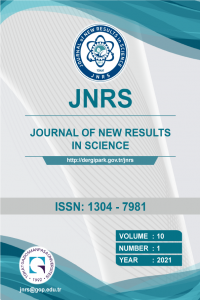Growth and Metabolite Production of Chroococcus minutus Under Different Temperature and Light Conditions
Cyanobacteria
consisting of valuable bioactive compounds reveal the pharmaceutical and
biological activities. In this work, the sample was collected from freshwater
and was isolated under inverted microscope. Identification was carried out by
morphologically. The isolated Chroococcus minutus was cultivated in
Bristol nutrient medium. Growth and norharmane production of Chroococcus
minutus under temperature and light conditions were presented. The most norharmane production and the cell numbers
were observed at 35 °C and irradiation of 1896 lux as 4.017 µg/g and 154.3 µg/g
respectively.
Keywords:
Chroococcus minutus norharmane, HPLC, temperature,
___
- Arrigo, K.R., 2005. Marine microorganisms and global nutrient cycles. Nature, 437: 349-355.
- Barros, M.P., Pinto, E., Sigaud-Kutner, T.C.S., Cardozo, K.H.M., Colepicolo, P., 2005. Rhythmicity and oxidative/nitrosative stress in algae. Biol Rhythm Res, 36: 67-82.
- Blunt, J.W., Copp, B.R., Munro, M.H.G., Northcote, P.T., Prinsep, M.R., 2003. Marine natural products. Nat Prod Rep, 20: 1-48.
- Cardozo, K.H.M., Guaratini, T., Barros, M.P., Falcao, V.R., Tonon, A.P., et al, 2007. Metabolites from algae with economical impact. Comp Biochem Phys C, 146: 60-78.
- Codd, G.A., Poon, G.K. 1988. Cyanobacterial toxins. Proceedings of the phytochemistry soci-ety of Europe. In Biochemistry of the algae and cyanobacteria, ed. Rogers, J., Gallon, J.R., Oxford, Oxford University Press, pp. 283-296.
- Dillon, J.G., Castenholz, R.W., 1999. Scytonemin, a cyanobacterial sheath pigment, protects against UVC radiation: implications for early photosynthetic life. J Phycol, 35: 673-681.
- Hašler, P., Dvořák, P., Johansen, J.R., Kitner, M., Ondřej, V., Poulíčková, A., 2012. Morphological and molecular study of epipelic filamentous genera Phormidium, Microcoleus and Geitlerinema (Oscillatoriales, Cyanophyta/Cyanobacteria). Fottea, 12: 341–356.
- Karan, T., Dastan, T., Baral, I., Altuner, Z., 2016. Effects of Differential Time Applications on Some Cyanobacterial Norharman Production Rates. Cumhuriyet University Faculty of Science, 37: 398-404.
- Kuhne, S., Lakatos, M., Foltz, S., Muffler, K., Ulber, R., 2013. Characterization of terrestrial cyanobacteria to increase process efficiency in low energy consuming production processes. Sustain Chem Process: 1-6.
- Muller-Feuga, A., Moal, J., Kaas, R. 2003. The Microalgae of Aquaculture. In Live Feeds in Marine Aquaculture, ed. Stǿttrup, J.G., McEvoy, L.A., Blackwell Publishing, Oxford, UK, pp. 206-252.
- Muruga, B.N., Wagacha, J.M., Kabaru, J.M., Amugune, N., Duboise, S.M., 2014. Effect of physicochemical conditions on growth rates of cyanobacteria species isolated from Lake Magadi, a soda lake in Kenya. J Sci Res, 2: 41-50.
- Pelah, D., Sintov, A., Cohen, E., 2004. The effect of salt stress on the production of canthaxanthin and astaxanthin by Chlorella zofingiensis grown under limited light intensity. World J Microb Biot, 20: 483-486.
- Radhakrishnan, B., Prasanna, R., Jaiswal, P., Nayak, S., Dureja, P., 2009. Modulation of biocidal activity of Calothrix sp. and Anabaena sp. by environmental factors. Biologia, 64: 881-889.
- Robarts, R.D., Zohary, T., 1987. Temperature effects on photosynthetic capacity, respiration, and growth rates of bloom‐forming cyanobacteria. N Z J Mar Freshwater Res, 21: 391-399.
- Tringali, C., 1997. Bioactive metabolites from marine algae: Recent results. Curr Org Chem, 1: 375-394.
- Tsujimura, S., Ishikawa, K., Tsukada, H., 2001. Effect of temperature on growth of the cyanobacterium Aphanizomenon flos-aquae in Lake Biwa and Lake Yogo. Phycological Res, 49: 275-280.
- Volk, R.B., 2008. Screening of microalgae for species excreting norharmane, a manifold biologically active indole alkaloid. Microbiol Res, 163: 307-313.
- ISSN: 1304-7981
- Yayın Aralığı: 3
- Başlangıç: 2012
- Yayıncı: TOKAT GAZİOSMANPAŞA ÜNİVERSİTESİ
